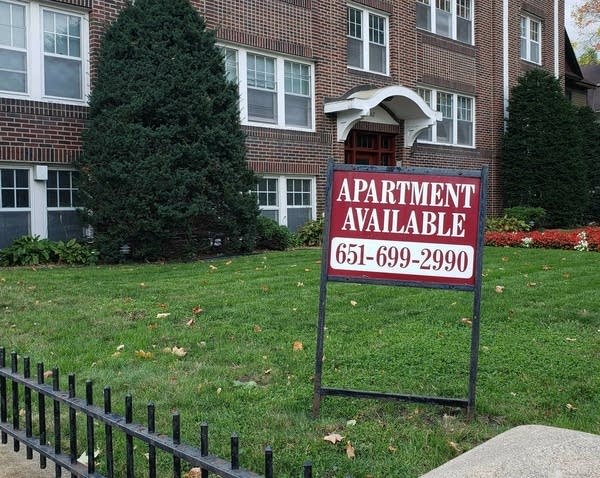What’s on the ballot: Rent control

Go Deeper.
Create an account or log in to save stories.
Like this?
Thanks for liking this story! We have added it to a list of your favorite stories.
Voters in both Minneapolis and St. Paul will weigh in on rent control on Nov. 2.
The measure on the ballot in Minneapolis would give the Minneapolis City Council power to limit rent increases.
St. Paul’s rent stabilization proposal is more specific and would be a first in the nation if passed. A coalition of housing advocacy and neighborhood groups gathered more than 9,000 signatures to put a proposed new ordinance on the ballot that would cap rent increases at 3 percent each year.
Unlike rent policies elsewhere, St. Paul’s cap would apply immediately to new apartment buildings as well as existing units. And, it would stop landlords from dramatically raising rents between tenants.
Turn Up Your Support
MPR News helps you turn down the noise and build shared understanding. Turn up your support for this public resource and keep trusted journalism accessible to all.
MPR’s senior economics contributor and guest host Chris Farrell was joined by a reporter, an advocate and an opponent to discuss the measures. They also took calls from listeners who shared their own opinions on the measure.
The Measure
Fred Melo, a reporter at the St. Paul Pioneer Press covering the ballot measure, explained how rent increases affect varying income brackets differently. For those renting in a new development, rent may increase as their wage increases. But more low-income tenants say their rent has increased by hundreds of dollars at a time. Much of this remains anecdotal. However, Melo said he has been hearing these stories again and again from tenants.
St. Paul is unique in its proposal, suggesting a 3 percent cap for rent increases year to year for all rental housing options. Critics of the measure cite the possibility of smaller landlords being pushed out of business due to rising costs of their own. Other criticisms include the ability for landlords to appeal the measure when needed. What will the process be for them? Will the city be inundated with requests? We don’t yet know, Melo said.
Voting Yes
Tram Hoang is the campaign manager for Keep St. Paul Home and an organizer of Housing Equity Now St. Paul, the coalition of housing advocacy and neighborhood groups behind St. Paul’s rent stabilization initiative. St. Paul is a majority renter city with no protections for renters, Hoang said. Rent can increase by hundreds of dollars for tenants, “causing displacement at best or homelessness at worst,” she said.
The number for the cap, 3 percent, was decided on by looking at a range of factors, she said. Research by the Center for Urban and Regional Affairs (CURA) indicates that it’s a number that won’t be detrimental to existing property owners’ operations.
Some opponents of the measure say it will eliminate incentives to build new properties. But according to CURA, it has not been shown that rent stabilization disincentivizes construction in cities.
Some also worry that local landlords will be pushed out of business for not being able to keep up with rising costs of their own. This fear and the subsequent fear of corporate consolidation in landlords is not realistic, said Hoang. The profit tool of already existing corporate landlords is rent increases. Consequently, support for the 3 percent cap is support for the local landlord, Hoang argued.
Another criticism is that the measure will only benefit those already living here in the Twin Cities. But under St. Paul’s measure, a landlord cannot raise the price of a unit after someone has moved out, Hoang said.
Voting No
Adam Duininck, the director of government affairs for the North Central States Regional Council of Carpenters, supports a no vote. Duininck has heard from companies and developers that if the measure was passed, construction would slow and investment would steer attention away from the central cities and out to the suburbs. Solutions to the housing problem in St. Paul, Duininck argued, is to have more investment from the state and federal government.
“What this initiative doesn’t tackle is supply,” Duninck said. Duininck argues the initiative fails to recognize how dollars are put into consumers’ pockets. Without job opportunities, tenants cannot pay their rent. This initiative would lead to fewer jobs in the housing sector, Duininck argued.
One solution could be an increase in investment in public housing, he said, along with proper recourse for those affected by high rent increases. Many rent stabilization advocates admit this proposed measure won’t affect many, he said, the issue then turns to dealing with landlords that enact these steep rent increases as well as providing tools for the victims.
Guests:
Fred Melo covers St. Paul for the St. Paul Pioneer Press
Tram Hoang is a campaign manager for Keep St. Paul Home and an organizer of Housing Equity Now St. Paul, the coalition of housing advocacy and neighborhood groups behind St. Paul’s rent stabilization initiative.
Adam Duininck is the director of government affairs for the North Central States Regional Council of Carpenters. He opposes the rent stabilization proposal in St. Paul.
Use the audio player above to listen to the full conversation.
Subscribe to the MPR News with Angela Davis podcast on Apple Podcasts, Google Podcasts, Spotify or RSS.
Dear reader,
Political debates with family or friends can get heated. But what if there was a way to handle them better?
You can learn how to have civil political conversations with our new e-book!
Download our free e-book, Talking Sense: Have Hard Political Conversations, Better, and learn how to talk without the tension.




